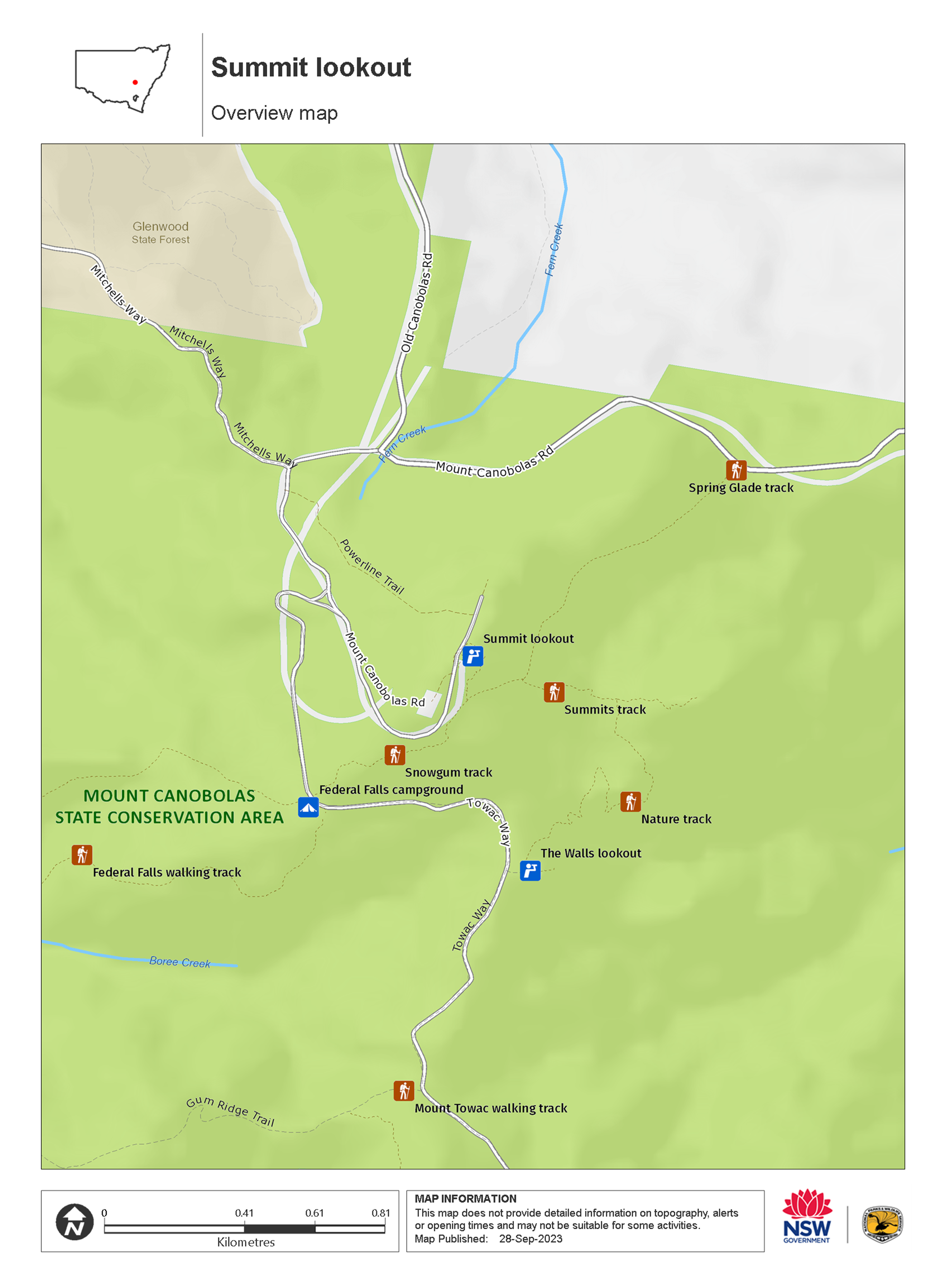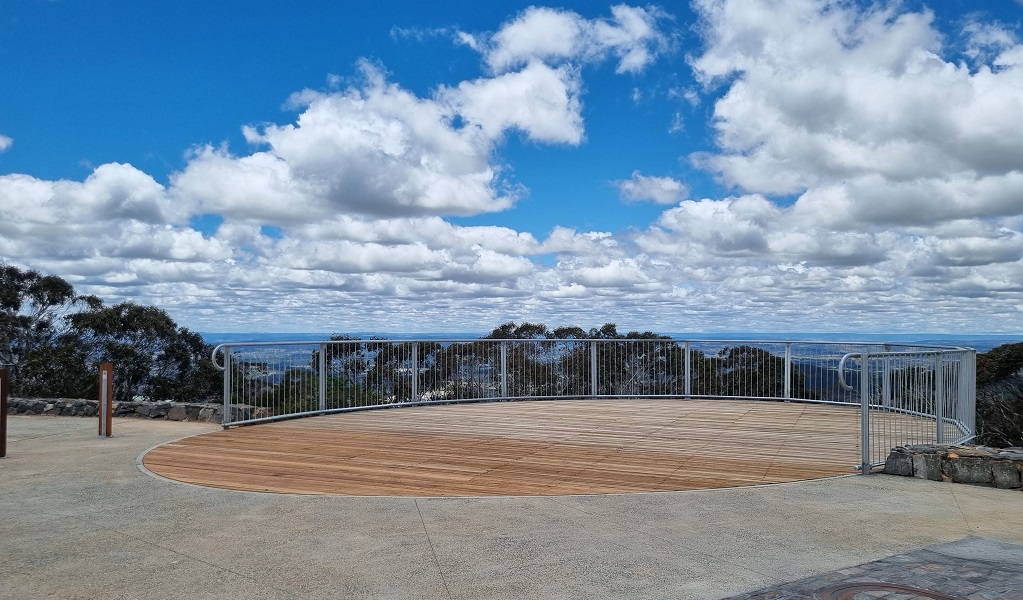Summit lookout
Mount Canobolas State Conservation Area
Overview
Summit lookout in Mount Canobolas State Conservation Area is the highest peak in central-west NSW and offers stunning views. Just 18km from Orange and easy to get to, it’s ideal for a quick trip.
- Type
- Lookouts
- Accessibility
- Easy
- Grade
- Easy
- What to
bring - Drinking water, sturdy shoes, raincoat, hat, suitable clothing, clothes for all weather conditions, first aid kit, sunscreen, snacks
- Please note
The Orange Visitor Information Centre is a good place to pick up maps of attractions in the area.
Summit lookout is a significant place for the Wiradjuri People, whose Elders say they can feel the spirits on top of the mountain. While you’re here, take in the Aboriginal artwork inset into the ground, and absorb this area’s importance in Aboriginal culture.
At nearly 1.4km above sea level, Summit lookout is the highest peak in central-west NSW. As you head up to it, take the time to enjoy the journey and admire your surroundings. And when you reach the top, you’ll find panoramic views of the park and beyond, including farmlands, vineyards and far off mountains.
Summit lookout is accessible, ensuring that everyone can enjoy these incredible views. It’s a great place for birdwatchers and nature lovers. The area is a haven for threatened wildlife and unique sub-alpine animals, plants and fungi, including endangered lichens. Look out for magpies and peregrine falcons flying through the Canobolas candlebark, as well as kangaroos, wallabies and the vivid yellow planarian worm. At night the area comes alive with rare species of gliders and bats.
Spring is a good time to visit, when you can see threatened birds like pied honeyeaters and Gilberts whistlers. In spring and autumn, keep an eye out for the orchids that come into bloom. And in summer, the peak provides some cool relief.
Bushwalkers can reach the lookout easily via Summits walking track. And cyclists and ultra-marathon runners can build their fitness on their way up to the lookout.
Nearby
-

Summits walking track
Summits walking track joins the two of the peaks within Mount Canobolas State Conservation Area. Walk it as a short walk or longer day walk, enjoying scenic views and birdwatching.
-

The Walls lookout
The Walls lookout is in Mount Canobolas State Conservation Area and connects to Nature walking track. It’s a great spot to see the view over the eastern reach of the park and Orange in the distance.
-

Federal Falls walking track
Take the challenging walk to Federal Falls near Orange. Keep your eyes out for birds and butterflies along the way and be rewarded with waterfall views at the end.
-

Mount Towac walking track
This short walk will take you to Towac Peak where you can enjoy panoramic views of Mount Canobolas State Conservation Area and the scenic countryside of Orange.
Map

Map legend

Local alerts
For the latest updates on fires, closures and other alerts in this area, see https://www.nationalparks.nsw.gov.au/things-to-do/lookouts/summit-lookout/local-alerts
General enquiries
- National Parks Contact Centre
- 7am to 7pm daily
- 1300 072 757 (13000 PARKS) for the cost of a local call within Australia excluding mobiles
- parks.info@environment.nsw.gov.au
Park info
- in Mount Canobolas State Conservation Area in the Country NSW region
Mount Canobolas State Conservation Area is always open but may have to close at times due to poor weather or fire danger.
Visitor info
All the practical information you need to know about Summit lookout.
Maps and downloads
Learn more
Summit lookout is in Mount Canobolas State Conservation Area. Here are just some of the reasons why this park is special:
An Australian menagerie

Mount Canobolas has an abundance of native animals which thrive in this special environment. Around 950 species of plants and animals have been recorded in the park, including several species that exist nowhere else in the world. Thornbills, treecreepers, flame robins, wrens and honeyeaters, as well as good old magpies, currawongs, rosellas, kangaroos and wallabies call Mount Canobolas home. Threatened and endangered species like the antechinus marsupial mouse and silver-leaf candlebark can also be found in the area. When the sun goes down, grab your torch to spot the many possums and wombats, all the while being serenaded by the southern boobook owl.
- Snowgum walking track Snowgum walking track is short and easy, it starts from the summit of Mount Canobolas or from Federal Falls campground. It’s a great way to work up a hunger for a barbecue lunch.
- Spring Glade walking track Spring Glade walking track provides easy access to the summit of Mount Canobolas via a pleasant easy walk through grassy woodland, offering birdwatching and picnic opportunities.
Ancient connections

Mount Canobolas State Conservation Area incorporates the traditional land of the Wiradjuri People. The name Canobolas comes from the Wiradjuri words Gaahna Bulla meaning two shoulders, referring to the two main peaks, Old Man Canobolas and Young Man Canobolas. The area has a strong Aboriginal connection as an important place for male initiation ceremonies and stone tool making, as well as being a rich source of food and medicines. Find out more about this area's Aboriginal heritage at Federal Falls campground.
- Summit lookout Summit lookout in Mount Canobolas State Conservation Area is the highest peak in central-west NSW and offers stunning views. Just 18km from Orange and easy to get to, it’s ideal for a quick trip.
Outstanding landscapes

Now extinct and with a violent past, Mount Canobolas was an active and aggressive volcano responsible for creating the landscape between 11 and 13 million years ago. The result? Mount Canobolas State Conservation Area boasts vents, dykes, peaks and plugs which all can be seen here and the large rocky outcrops are home to rare lichens, towering basalt cliff lines and impressive waterfalls. The high altitude, cool climate and moist environment make this fertile ground for more than 300 plant species in the region. Large areas of snow gum subalpine woodland, grassy woodland and rocky outcrops covered with a variety of mosses and lichens make this a great place to visit. It’s hard to say what is most beautiful here, but certainly the heaths in spring which burst with purple, white, yellow and red flowers are a sight to behold.
- Mount Towac walking track This short walk will take you to Towac Peak where you can enjoy panoramic views of Mount Canobolas State Conservation Area and the scenic countryside of Orange.
Rising from the ashes

Mount Canobolas is recovering strongly from devastating fires that burned nearly 70% of the state conservation area in 2018. NPWS staff is working with the Orange Field Naturalist and Conservation Society to monitor, audit, and survey plant vegetation communities, insect and animal species, and Aboriginal sites. The park’s after-fire monitoring and conservation program has increased the number of known plant and animal species in the park, including discovery of 2 new ground orchid species new to science and rediscovery of 2 orchids unseen for over 20 years. As animals return, trees sprout new growth and plants come back there’s hope for the recovery of our native plants and animals.
Plants and animals protected in this park
Animals
-

Superb fairy wren (Malurus cyaneus)
The striking blue and black plumage of the adult male superb fairy wren makes for colourful bird watching across south-eastern Australia. The sociable superb fairy wrens, or blue wrens, are Australian birds living in groups consisting of a dominant male, mouse-brown female ‘jenny wrens’ and several tawny-brown juveniles.
-

Common ringtail possum (Pseudocheirus peregrinus)
Commonly found in forests, woodlands and leafy gardens across eastern NSW, the Australian ringtail possum is a tree-dwelling marsupial. With a powerful tail perfectly adapted to grasp objects, it forages in trees for eucalypt leaves, flowers and fruit.

